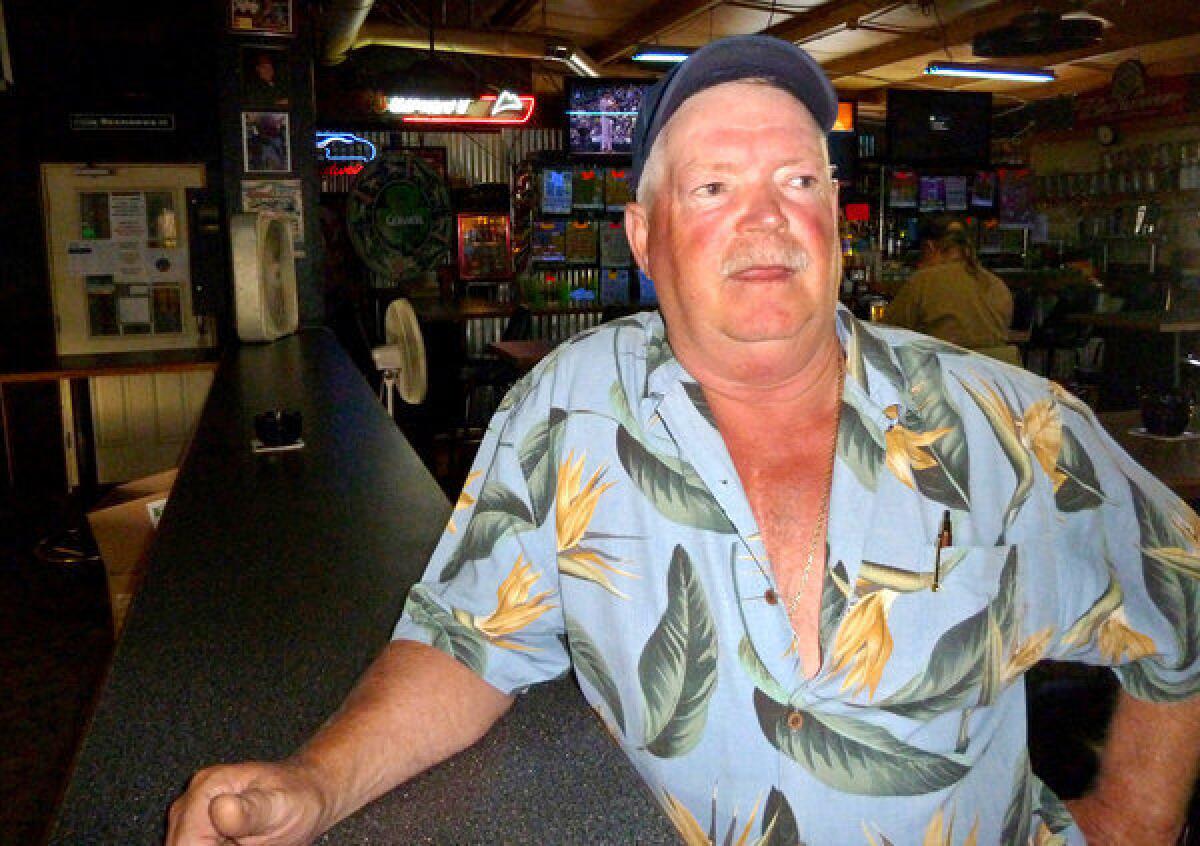Giving new life and an old home to struggling sea lion pups
For the Marine Mammal Care Center in San Pedro, the goal was simple: Revive the ill, abandoned pups and return them to the sea.
T
he pickup crept down the steep drive to the beach at White Point in San Pedro. When the driver reached the bottom, he carefully backed the truck as close as he could to the water, the surf fizzing like soda being poured in a glass of ice.
It's a route that Harry Mansfield, a volunteer at the Marine Mammal Care Center a few miles away, could probably travel with his eyes closed by now.
For the last few months, he's repeated the routine as many as a dozen times a week: delivering sea lion pups that once nearly died in these waters off Southern California to a second chance at life in the wild.
Although the waves were choppier than Mansfield would have preferred, the sea lions, waiting in their crates, perked up as soon as they caught a whiff of the salt in the air, their whiskers twitching.
They were eager to splash into the ocean.
But the year-old sea lion known as 534 huddled in his crate. He'd come to the center May 11, after being found stranded on a beach in Malibu, more dead than alive.
Two months later, he'd nearly tripled in size. Every test showed he was healthy, ready for the wild.
Yet here he was, hesitating, as the currents of a vast ocean waited to draw him back in.

As soon as the year began, veterinarian Lauren Palmer could tell something was wrong.
January was traditionally a slow period for sea lions at the San Pedro care center. But nearly 50 sea lions had come in, more than twice than the year before. In February, 105 were admitted. The next month, nearly 240.
It was the same in care centers from San Diego to Santa Barbara, all inundated with the months-old pups that had washed up on shore.
An emaciated sea lion pup huddles closely with another sick pup while undergoing critical care at the Marine Mammal Care Center. More photos
They arrived severely malnourished, often suffering from other ailments and injuries they picked up as they grew weak. Their ribs poked through their fur. They would sprawl out on the floor of their pens, with barely enough energy to yawn.
"They were emaciated, listless," said Christopher Nagle, a marine biologist at the center. "They were just pitiful."
By March, federal wildlife officials declared an "unusual mortality event," a designation that mobilized researchers to figure why mothers had abandoned their young. A working theory among some scientists is that mothers left in search of food, and were forced to travel farther because of a short supply.
Researchers have also examined other potential causes: toxins, such as the domoic acid released by algae and a threat to sea lions in the past, or perhaps an illness that spread through the sea lion population.
The San Pedro center, in a typical year, might take in a couple hundred California sea lions. Eight months into the year, they were well past that, admitting about 500 sea lions.
"It was a very, very busy spring," said Palmer, dressed in scrubs, her sandy hair pulled back.
She was the one who would decide their fate: She signed off before Mansfield could load them in the pickup, found them a permanent home if she knew a patient could never fend for itself in the wild, or made wrenching decisions to end a life if there was no hope of recovery.
She flipped through the pages of 534's file, his chart practically identical to the hundreds of others she'd seen over the last few months. He arrived at the center having difficulty breathing and weighing only 10 kilograms, or 22 pounds.
"At 10 kilos, that's a pretty skinny little animal," she said. In a case like his, she noted, "the prognosis is not good."
At 10 kilos, that's a pretty skinny little animal. In a case like his, the prognosis is not good."— Veterinarian Lauren Palmer
The number was etched into his suede-like fur. It was based on the order in which he had arrived, and also served as his name.
The workers at the center don't name their patients. They use plywood shields whenever they approach the animals for the same reason. The pups' big eyes and soft coat may seem like an invitation to nuzzle them like a teddy bear, but they're wild animals and need to stay that way if they stand a chance of surviving in the sea.
Weeks after his rescue, 534 squirmed in his crate as he was weighed. He'd plumped up to 31.5 kilograms.
The doctor nodded approvingly. "That's a good amount of weight," she said.

At first glance, the San Pedro center could pass as a retrofitted dog kennel, a series of chain-link pens, where sea lions and seals splash in pools, slide on wet concrete and yap loudly as they jostle with one another.
The center — funded mostly through private donations and grants — is set back on Fort MacArthur, at the tip of the San Pedro peninsula, a hazy blue horizon in one direction and the port, dotted with different colored ships, cranes and stacked storage containers, in another.
This spring, the sea lion pups claimed space all over the center: A storage room was emptied to hold 10. The room where Palmer performed necropsies took in 30 more.
"There was no visible concrete," Palmer recalled. "Everywhere you looked, there was a sea lion in it or on it."
The patients have already eaten through the center's annual budget of up to $80,000 for capelin and herring, officials at the center say. At one point, the center was going through thousands of pounds of fish each week.
"It's stressed the system," Nagle said. They've been able to get by, he said, because of the tireless crew and Palmer, who has remained level-headed in the face of considerable pressure.
"She never loses her cool."

Palmer backed into a life of caring for animals. She worked for 20 years in the film business, as a sound editor. She was content with her old life, she said. She enjoyed her work.
But she had dreamed when she was younger of being a marine biologist. She thought one day she'd work at an aquarium and care for fish. "I wanted to go back," she said, "and see if I could pursue the thing I've always wanted to do."
As a veterinary student, enrolled at the University of Minnesota, she volunteered in San Pedro. She worked for a time treating horses in Ventura County, but she wanted to return to marine life and to San Pedro.
In the eight years since her return, as staff veterinarian, she rediscovered something about her work she found so gratifying: seeing a vulnerable creature become vital, and knowing she had played a part in that.
Palmer has clung to that as the days wore on, the demands piling up.
There were the ones she couldn't help: At the most critical point, nearly half of the pups wouldn't make it, many dying within hours of being rescued and before Palmer even had a chance to diagnose them. There were the others, who would survive but would never be able to return to the wild.
And there were the pups that got better. The helpless little ones that once could get nutrition only through a tube, now waddling away from the huddle at feeding time with a herring's tail poking out of their mouth.
There are definitely days I feel inadequate, days I wish were different. But we're making a lot of progress, and helping a lot of animals."— Veterinarian Lauren Palmer
That, she reminded herself, was why she was here.
"There are definitely days I feel inadequate, days I wish were different," Palmer said. "But we're making a lot of progress, and helping a lot of animals."

In recent weeks, the tide has shifted: More sea lions were going out than coming in. Storage rooms were holding supplies again.
And on this July afternoon, Palmer was ready to let some more go.
She kept tabs on her patients' weight and the results of blood work. But the final call hinged on something no test would reveal. She watched their behavior, how they acted when workers flung fish into the pens or a cluster of pups wrestled in the pool: Could they hold their own?
It's a tricky decision, she said. Unless they're found stranded again, Palmer doesn't know what happens to her patients once they leave her care. "They don't send postcards!" she joked.
She walked through kennels, looking for the ones she thought could be released. She spotted 534. She picked four others. She considered letting one more go, but changed her mind.
A Northern elephant seal is guided to the water at White Point/Royal Palms Beach in San Pedro for an afternoon release. More photos
"I'm not going to send 380," she called out to one of her interns, who'd grown attached to this particular sea lion. "He could use a few more pounds."
The others were hauled over to Palmer's exam room for one last look.
One of them had been a patient of hers for a while. She looked at her notes: No. 157, admitted Feb. 26. He was underweight, like most, but also had eye troubles.
He still had limited sight in one eye, but she thought he could handle himself in the wild. "It's as good as it's going to get," she said. "He's bigger, stronger and, hopefully, he'll do OK."
She has come to care for the pups. But as she sends them off, she hopes she never sees them again. That means she did her job right.

Mansfield and other volunteers lugged the crates down the rocky coast, resting them at the water's edge.
One by one, they unhitched the locks on the crates, and the sea lions pushed their way out. They scampered into the water, flopping their way through the incoming waves.
When 534's turn came, he was timid. He poked his head out, then retreated into the crate. Mansfield had to shake the crate to get him out, and he immediately dashed into another one.
At last, he ventured into the water. For a few moments, he kept popping up and looking back at the beach. Then, a wave washed over his head and he vanished, off to start his life again.
Follow Rick Rojas (@RaR) on Twitter
Follow @latgreatreads on Twitter
More great reads
Syria divided: Crossing a bridge where a sniper waits
Life has to go on. People cross and someone gets shot and they pick up the martyr and keep going."
Sign up for Essential California
The most important California stories and recommendations in your inbox every morning.
You may occasionally receive promotional content from the Los Angeles Times.









